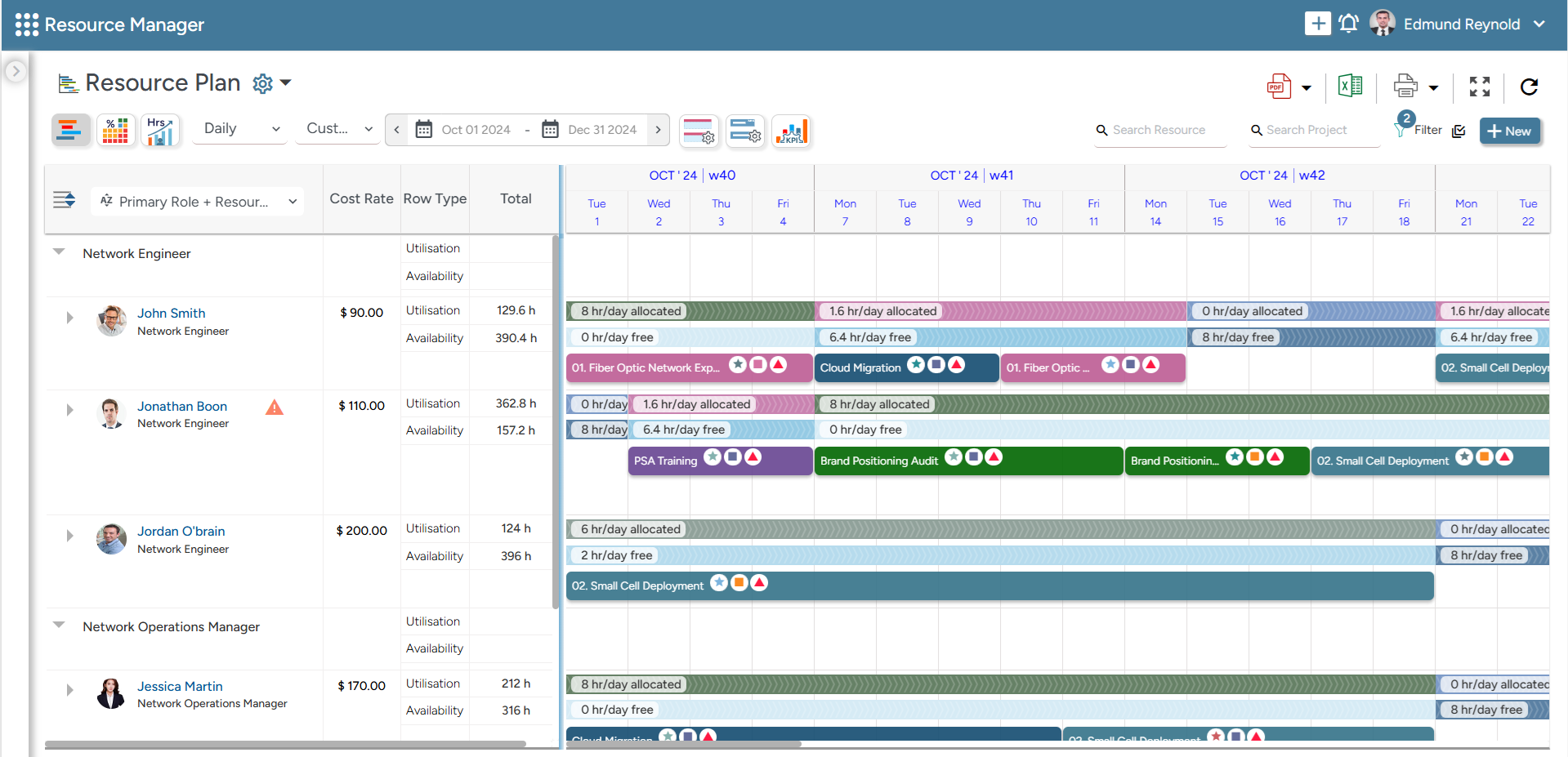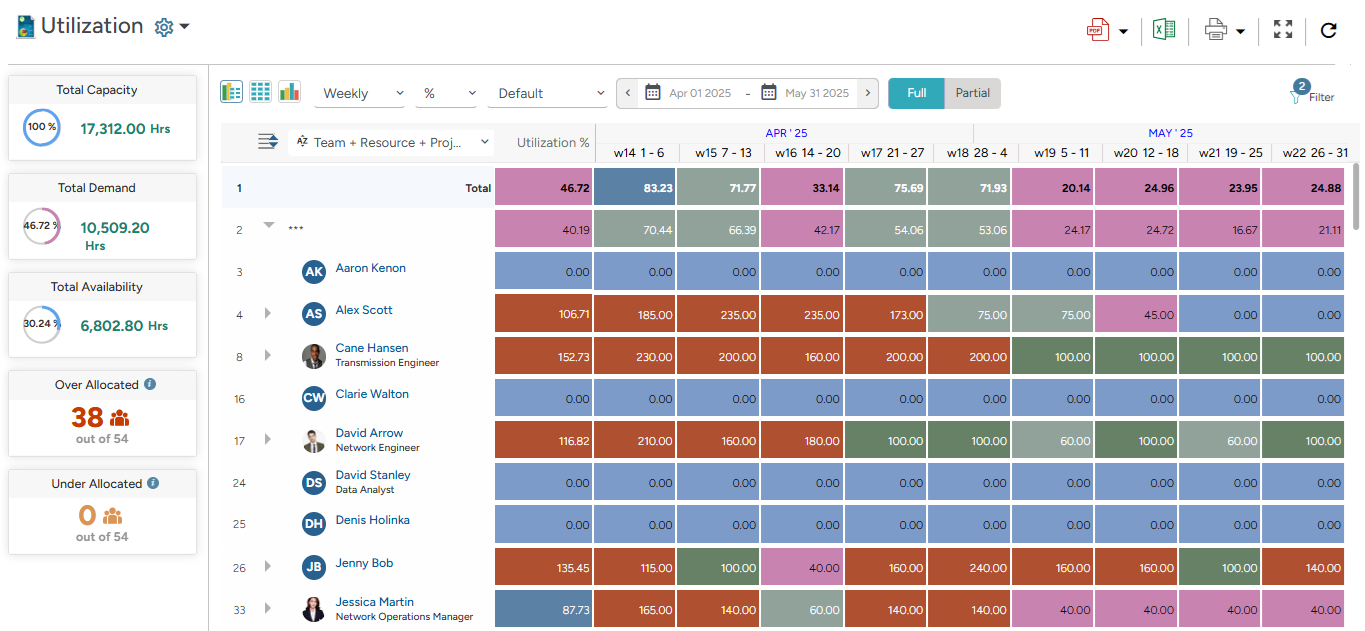According to Harvard Business Review, “78% of employees believe their organizations lack diversity in leadership roles.”
This statistic clearly reflects the inequalities that still exist in our workplaces. Despite growing awareness and global discussions around equity and inclusion, diversity in the workplace is still lacking.
In project management, teams are expected to work on complex problems, manage constraints, and deliver measurable results. However, in the absence of a diverse workforce, project teams risk missing out on valuable perspectives and insights, resulting in one-dimensional, obsolete solutions that fail to address the needs of a broader audience.
That’s why diversity in project management is critical to challenge groupthink, foster innovation, and drive successful outcomes. When teams consist of individuals from different cultural backgrounds, age groups, genders, and professional experiences, they are better equipped to generate creative solutions and make more informed decisions.
This article comprehensively covers diversity in project management, its history, types, benefits, challenges, and effective strategies for fostering a truly inclusive and high-performing project environment.
Let’s begin!
What is Diversity in Project Management?
Diversity in project management refers to the inclusion of individuals from different backgrounds, genders, cultures, and professional experiences within project teams and leadership. Practicing diversity provides a liberal environment for the workforce to share their views and express their talent freely. A diverse project team brings different perspectives to the table, which enhances employee productivity and improves problem-solving
When organizations actively promote inclusion within their project teams, they create a safe space for individuals to think independently and cohesively. In addition, diversity in project management nurtures individual talent and strengthens team dynamics, leading to higher employee morale and improved productivity.
Now that we understand diversity in project management, let’s quickly look into its evolution and where it stands today.
History and Current Scenario
The foundation for diversity in project management was laid in 1964 with the Civil Rights Act, which prohibited discrimination against employees based on race, gender, or religion. Later, in 1965, another executive order was passed to promote equal employment opportunities in federal services. Additionally, in the 1980s and 1990s, diversity gained further traction as organizations began to adopt policies to foster inclusion.
Today, diversity in project management is recognized as a key driver of organizational success. That’s why companies are implementing diversity metrics, unconscious bias training, and inclusive leadership in project management to strengthen collaboration across teams. Additionally, the rise of remote work models has led managers to lead globally distributed multicultural teams. This has created opportunities to foster cross-border synergy and leverage diverse perspectives for better outcomes.
Now that we have understood diversity and its history let’s move on to the types of diversity in project management.
Types of Diversity in Project Management
Diversity in project management includes various types, and each has its impact on the workforce. Below mentioned are a few types; let’s have a look.
Gender Diversity
Gender diversity in project management refers to the fair and balanced representation of different genders and the provision of equal opportunities in terms of compensation, promotions, leadership, etc. When project teams are gender diverse, they benefit from a wide range of perspectives, collaborative strengths, and leadership styles, leading to stronger and high-performance work teams.
Cultural Diversity
Cultural diversity in a workplace refers to uniting team members from different walks of life, norms, and values. This enriches projects with varied perspectives and approaches to problem-solving. However, managing cultural differences can be challenging due to variations in values, communication styles, and work ethics. Effectively navigating these differences can lead to a more holistic project outcome.
Read More: How Can Your Work Culture Improve the Employee Experience?
Skillset Diversity
Skillset diversity in project management involves team members with various skills, knowledge, and professional expertise such as design capabilities, data analysis, leadership, and communication strategy. This inclusion allows team members to approach challenges from multiple angles, offering varied perspectives. It also enables project managers to build agile teams better equipped to handle complex project environments.
Generational Diversity
It refers to the coexistence of a multigenerational workforce, such as Baby Boomers, Millennials, Generation Z, etc. Each generation brings its values, experiences, and work preferences. For instance, younger team members may be more tech-savvy and innovative, while older professionals often bring deep industry knowledge and leadership experience.
Read More: Productivity Tips for the Multigenerational Workforce
We have seen different types of diversity in project management, so now, let’s look at the benefits of having diverse project teams.
Benefits of Diversity in Project Management
A diverse team brings together individuals with different experiences, perspectives, etc., providing several advantages, such as:
Helps Build a Diverse Talent Pool
Embracing diversity in project management allows organizations to attract and hire individuals from different backgrounds, ethnicities, beliefs, skills, etc. By fostering inclusivity in talent acquisition strategy, organizations can acquire untapped talent. This brings together individuals with unique perspectives and problem-solving approaches, forming more innovative, adaptable, and resilient project teams.
Provides Access to Global Talent
With the rise of remote work culture and advanced digital collaboration tools, organizations can access global talent like never before. Project managers can tap into international expertise to build versatile teams enriched with diverse perspectives and specialized skills. This global approach enhances cross-border collaboration and supports localized delivery that resonates with regional markets.
Read More: 7 Key Challenges in Global Project Management & How to Resolve Them
Improves Problem-Solving and Decision-Making
“Diversity enables teams to get to better answers and better solutions” – Blair Taylor
This is because resources from different backgrounds and places bring different attitudes and experiences to the team. Therefore, when a problem arises, diverse teams consider a broader range of alternatives and approach challenges from multiple angles. Thus, diversity in project management enhances decision-making, accelerates problem-solving, and avoids potential project delays, resulting in better outcomes.
Offers More Ground Space for Innovation
As per the study, “Inclusive companies are 1.7 times more likely to be innovation leaders in their market.”
The above statistic underscores a strong link between diversity and innovation. Teams composed of individuals from different demographics and professional expertise are more experimental and open to unique ideas. Additionally, their varied backgrounds drive fresh ideas and effective strategies, enabling project teams to develop forward-thinking solutions that better align with market needs.
Read More: – What is Innovation Management, and Why is it Important?
Enhances Market Reputation and Brand Value
Companies that champion diversity and inclusion are seen as progressive, ethical, and socially responsible. These qualities significantly elevate their brand image. Moreover, such companies earn greater trust and loyalty from clients, partners, and investors who increasingly seek to associate with brands that mirror their own values. Thus, having inclusive project resources boosts market reputation and brand value.
Better Project Performance and ROI
As per the GlobeNewswire, “Diverse companies earn 2.5 times higher cash flow per employee, and inclusive teams are more productive by over 35%.”
This statistic underscores the powerful link between diversity and business’s profitability. Teams with diverse perspectives tackle challenges with a broader range of ideas and solutions, leading to higher-quality work. The inclusive project team also tends to communicate more openly, collaborate more efficiently and make well-informed decisions. Thus, they improve overall performance and boost ROI.
Read More: – Operational Efficiency: What is it, and How to Maximize & Boost ROI?
After exploring the benefits of diversity in project management, let’s understand its various challenges.
Challenges of Diversity in Project Management
Diversity offers various opportunities for businesses to grow, but bringing a diverse group of people together also leads to certain challenges. Let’s look at them:
Potential for Internal Conflict Due to Cultural Barriers
Cultural and other social differences bring a shift in mindsets and thought processes within the team. However, this shift can sometimes lead to distrust and discrepancies between individuals. Additionally, if the team is not trained to embrace diversity, they may resist diverse ideas, leading to internal conflicts. Over time, these disputes can disrupt team cohesion, slow down workforce efficiencies, and harm the project’s performance.
Unfair Recognition to Some Employees
A Glassdoor poll found that “66% of female professionals do not believe they’re being paid fairly for the work they do, compared to 59% of male professionals.”
This disparity reflects a broader issue: while some companies promote diversity only to look good on paper, true inclusion often lacks behind-the-scenes. In such cases, managers may show bias in employee recognition and rewards without objective evaluation. This not only hinders the growth of deserving employees but also leads to resentment, disengagement, and workplace divisions.
Read More: – Employee Recognition Programs: Types, Benefits and Best Practices
Unconscious Bias Leading to Microaggression and Disengagement
Diversity and inclusion are critical values that can lose their impact when undermined by unconscious bias. These biases often surface as microaggressions (subtle or indirect comments) that hurt and isolate certain team members. When such behavior occurs repeatedly, affected individuals feel undervalued or excluded. This emotional toll causes disengagement and eventually leads to unplanned attrition.
Difficulty in Building Cohesion & Team Bonding
When individuals come from different cultural norms, linguistic, generational, and professional backgrounds, their communication and conflict-resolution approaches vary significantly. Without a shared sense of understanding, team members struggle to connect personally or professionally. Globally distributed or remote teams further add another layer of complexity, making it difficult to build cohesive project teams.
Read More: – How to Foster Trust and Transparency in Remote Teams
Difficulty in Balancing Diverse Opinions During Decision-Making
With diverse perspectives, aligning everyone on a single course of action becomes challenging. Conflicting viewpoints can lead to prolonged discussions, delayed decisions, and sometimes internal friction. Differing priorities, project communication styles, and interpretations of goals can further complicate consensus. These challenges can also lead to misunderstandings, delays, and stalled progress.
Collaboration Issues Due to Varying Time Zones
Diversity in project management is not just limited to culture or gender; it spans geography and regions. When members operate from different parts of the world, scheduling real-time project meetings, aligning on updates, and ensuring timely communication can become difficult. As a result, even simple tasks may take longer to resolve, affecting project momentum and delivery timelines.
Read More: – What are Remote Teams? 12 Effective Strategies to Manage Them
Next, let’s look at some robust strategies to foster diversity in project management.
Strategies to Foster Diversity in Project Management
The following strategies provide a structured approach to integrating diversity in project management practices.
Implement Cultural Awareness Training
In diverse project teams, employees often bring unique cultural values, beliefs, and perspectives shaped by their regional and social backgrounds. However, differences in communication styles and work culture can create misunderstandings and conflict among teams. To address this, managers can provide culture awareness training that educates team members on cultural norms, implicit biases, and inclusive practices.
These sessions can include real-life scenarios, interactive workshops, and expert-led discussions to help team members navigate cultural differences in a respectful way. Furthermore, when managers and team members understand cultural sensitivities, they can make better decisions that support inclusivity. This results in a more harmonious workplace where everyone feels seen, heard, and respected.
Create an Inclusive and Positive Work Environment
While promoting diversity is essential, building an inclusive project team is equally important. Diversity brings unique individuals to the table, and inclusion ensures that everyone feels safe, respected, and supported to contribute their ideas. This keeps teams engaged throughout the project lifecycle, resulting in high morale, increased productivity, and stronger project outcomes.
To cultivate such an environment, organizations can implement fair policies, provide a common platform for sharing ideas, and offer equal opportunities to all. For example, project managers can introduce anonymous idea-sharing tools to boost the participation of non-native English-speaking team members. This can even help them gain valuable input to improve project workflows.
Read More: What is a Project Lifecycle? Phases, Importance, & Best Practices
Adopt a Structured Decision-Making Framework
As much as different views can quicken problem-solving, too many opinions can cause confusion and chaos, leading to confusion in decision-making. Project managers can adopt structured frameworks such as Multi-criteria Decision Analysis (MCDA) or Delphi Method to avoid this. These techniques bring objectivity, clarity, and consistency to the decision-making process.
Additionally, these frameworks enable managers to gather input from all the project stakeholders systematically. This promotes equal participation and ensures that different viewpoints are valued. Thus, combining inclusivity with a structured decision-making framework result in more innovative solutions that reflect the team’s collective intelligence.
Standardize Performance Evaluation Criteria
One of the main challenges project teams face in diverse cultures is bias, leading to unfair evaluations and inconsistent recognitions. However, by implementing standardized evaluation criteria, managers can ensure that all team members are assessed based on their skills, approaches, and contributions rather than subjective opinions.
Additionally, managers can define KPIs like task completion rate, quality of deliverables, and adherence to timelines to assess the team’s performance. This structured process prevents favoritism or discrimination from influencing recognition, promotions, or career growth. Moreover, this fosters trust and transparency, boosts employee morale, and strengthens their confidence in leadership.
Read More: – Traditional Performance Appraisals: Are They Still Relevant?
Use Overlapping Hours for Team Meetings
In a global project environment, where remote teams often span multiple time zones, scheduling meetings that accommodate everyone can be a major challenge. In such scenarios, it is essential for project managers to be mindful of each member’s working hours to ensure fair participation and employee engagement. For example, they can use overlapping hours (when two or more time zones share a standard working hour).
This ensures the participation of all members, improving cross-department collaboration, fostering inclusivity, and reducing feelings of exclusion. For example, a project team spread across New York, London, and Bangalore establishes a weekly check-in during a shared 90-minute window to keep everyone aligned on project priorities and ensure smooth delivery.
Facilitate Team-Building Activities
Building a strong, cohesive team is essential to manage diversity in project management. Team-building activities such as cultural programs, informal social interactions, team outings, and collaborative workshops can break down interpersonal barriers. These initiatives foster open communication, build trust, and promote mutual understanding among employees, which is essential for teamwork.
Furthermore, such activities allow employees to explore various cultures, share unique perspectives, and express their ideas freely. Organizations can encourage creativity and inspire innovative problem-solving by creating space for meaningful exchanges. This leads to improved performance and drives better project outcomes.
Read More: – 7 Benefits of Virtual Team Building Activities for Remote Teams
After strategies, let’s now understand how a resource management tool can help manage diversity in project management.
How Can Resource Management Tools Catalyze Diversity in Projects?
Advanced resource management software offers a myriad of functionalities that help seamlessly manage diversity in project management.
- The all-in-one resource planner enables managers to slice and dice the resource information across various dimensions like role, experience, expertise, location, cost, etc. This makes identifying the most competent resource from the diverse pool easy, ensuring equal opportunity.

SAVIOM’s All-in-One Resource Planner gives complete insight into resource-centric attributes like role, expertise, location, experience, and cost.
- With 360-degree visibility into the global talent pool, managers can seamlessly oversee hybrid and cross-border teams. This is especially critical when leading culturally and regionally diverse teams.
- The intelligent match-making function ensures that managers assign the right personnel to the right project at the right time and cost, ensuring data-driven decisions are transparent and free from favoritism.
- The tool’s KPI forecaster provides valuable insights into key metrics like utilization, capacity, availability, and people on the bench. This ensures optimal workload distribution among project teams.
- The embedded heat mapping facility helps managers quickly identify over/underutilized professionals and optimize their workloads to improve the resource health index.

SAVIOM’s color-coded heatmaps make it easy to identify underutilized and overallocated resources, enabling managers to take corrective actions
- The in-built collaboration platform ensures that diverse project teams stay informed with real-time updates and project milestones. It eliminates information silos and encourages open, inclusive communication across all team levels.
Conclusion- Diversity over Discrimination
“Diversity is about creating an environment where a person can bring their whole self to work.” ~ Laure Miller
The quote is a holistic explanation of the essence of diversity. Every individual carries a unique identity and talent inventory to the team. When they are given equal opportunity, they can contribute significantly to an organization’s success. Ignoring diversity limits talent and constrains an organization’s innovation and growth. In the current situation, people have realized the necessity of diversity and thus are revolting against discrimination.
So, what is your approach to ensure diversity in project management?
Glossary
Read More: Glossary of Resource Workforce Planning, Scheduling and Management












